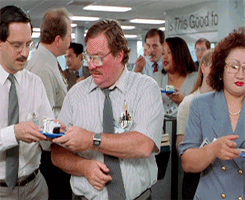25 Failsafe Rules I Failed*
The dad who co-wrote a popular list of ways to raise daughters reflects on which rules he followed, broke, or ignored. (*Not a complete failure.)
2012 listicle goes a little viral
In 2012, I co-wrote an article with my friend and colleague, Joanna Schroeder, called 25 Failsafe* Rules for Dads Raising Daughters. It opened like this:
All daddies with little girls want to raise them “right”, but how the heck are they supposed to know what that means?
If you spend any time on the Internet these days, you’ll quickly learn that pithy numbered lists are the path to enlightenment. It is in that spirit that we have collaborated to develop this list of rules that are guaranteed to guide fathers in the correct way to raise their daughters. This wisdom is universal, proven, and failsafe.*
*Not really.
Marcus is raising two toddler daughters, and Joanna is a daughter (in addition to being a mother) so we feel we have at least as good a chance as anyone at enlightening others. We are colleagues and friends, and while we find we disagree on many things, one area in which we often find common ground is raising kids.
We agreed on many of these rules, though some only made it in when the other one wasn’t looking. For the tl;dr demographic, here’s the list in a nutshell:
Joanna says dads should be girly with their daughters. Marcus says dads should be manly with their daughters. It’s okay to be both.
As the asterisk note disclaimed, the “failsafe” claim was tongue in cheek, not based on rigorous research. We were two parents having fun writing together. This article became the most (and only) viral thing I’d ever written.
It didn’t go so massively viral that everyone has heard of it, but it got big traffic where it was originally published, was re-printed in other places for more traffic, and got discussed in some podcasts and shows, including most notably, “The View”.1
Unless Joanna got secret compensation that I never knew about, neither of us saw a penny for authoring it. I don’t think it made anyone rich, but I’m sure it generated enough monetized traffic that it would have been nice to get a piece of the pie we helped bake.
The article was a pithy numbered list, a.k.a. “listicle”, and the Internet loves that. My original draft was probably 40 rules and multiple paragraphs accompanying each before Joanna added some and trimmed some to keep it pithy.
Revisiting “25 Rules” in 2017
When I read it now, I still like it and am proud of it, but some parts resonate differently than they used to. Some have stopped ringing altogether.
At the time I knew exactly which parts I’d written and which parts Joanna had, but a lot of that is fuzzy in my memory now. Some parts I can still distinguish right away, but others feel like we both contributed, or I can’t tell who wrote what. We didn’t agree on everything even when we co-wrote it, but I still like and respect Joanna despite our areas of disagreement.
My twin daughters were a few months past 3 years old when we wrote this, so I was still relatively new to fatherhood. We (my wife and I) were still a few years away from finding out our twins were both on the autism spectrum, so at that point we just felt like parenting was really, really hard for no particular reason, so it must be our fault. An optimistic list of rules felt good to write as a confidence booster for myself.
A lot of the rules were more aspirational than proven wisdom, and some of them still are since a few parenting challenges don’t kick in much ’til later – like how to approach sexuality.
With my daughters closing in on 9 years old, I thought it was time to revisit my own “failsafe” rules and see how I was doing. True to my essayist roots, I’ve written additional commentary for each of the rules, so the total word count is much higher now – too much for a single article.
Joanna, already a mother of two boys when we wrote the original, is now expecting her first girl, so I figure what better present for her first daughter than 10,000 or so unsolicited words from an old friend.
In case it’s not obvious already, this addendum to “25 Rules” is not co-authored like the original. I give full credit and thanks to Joanna for co-authoring that piece, but what follows has not been co-written, edited, or otherwise endorsed by her. If you find any of it offensive or objectionable, that’s on me, not her.
Revisiting “25 Rules” in 2022(ish)
Here’s the thing: I completed the above-referenced update in 2017, but I never published it or wrapped it up in a bow as a baby shower present for Joanna or her daughter. We never had a falling out, but we stopped keeping in touch. She continued editing and writing all along, most recently at
. Parenting is still one of her topics and her writing still kicks ass.The 2017 update continues to reflect to my experience up to that time, but now it’s out of date. It’s time to update the update.
Much has happened in five years. My daughters’ minds and bodies are five years older, which includes the onset of puberty. I’d like to say they’re five years more mature, but it doesn’t always feel that way.
I’m five years older. Five years wasn’t enough to make me feel a lot different most of my adult life, but now that I’m into my 50s, I’m feeling noticeably different than I did five years ago. Cognitive decline is
The Covid-19 pandemic started three years ago. That has disrupted some families more than others, but for ours, it meant a solid year of stricter household isolation than most families. Even as we expanded our bubble after that first year, we remained more isolated and cautious than most folks. We’ve avoided catching it (so far), but that has come with a cost, especially socially. For those of us predisposed to anxiety, it has made the anxiety worse.2
Because our special needs daughters responded so poorly to “distance learning” when it started at the end of their 5th Grade, we decided to homeschool for Grade 6. We didn’t set out to homeschool for all of middle school, but that’s what we ended up doing. That, plus rarely being outside the home for time away from kids and family, while parenting special needs daughters, has made my experience of fatherhood about as non-universal as you can get.
At times it all feels so atypical I can’t even relate to myself, like – who lives like this? I’m definitely not speaking for all dads, either descriptively or prescriptively, but I hope that bits here and there might amuse or reassure some parents out there that they’re not alone, which would then reassure me that I’m not alone.
Over the next several weeks, I will publish my 5-year and 10-year updates as a series. Most installments will consist of one of the rules as they appeared in the original, followed by my 2017 and 2022 updates and commentaries. That will make for at least 26 installments, counting this concise3 introduction. If I decide to add some related thoughts that don’t quite fit in with any specific rule, it’ll be more.
I was unable to find a clip available anymore, but based on an old email link, I think it was episode 816, some time in the summer of 2012. Check your Tivos if you didn’t delete all your The Views yet.
Roughly 75% of our household struggles with varying degrees of anxiety, and I only get to that number by counting 2 out of our 4 cats as “mellow”. For humans only, it’s 100%, but not 100% of the time.
You heard me.


